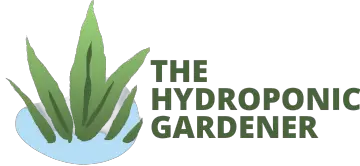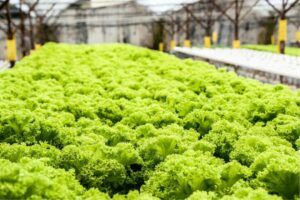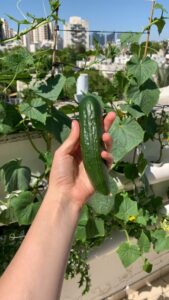Are hydroponic microgreens as healthy as traditionally grown ones? It’s a common question among health-conscious individuals looking for nutrient-dense foods.
A study conducted by the USDA shows that microgreens can contain about 40 times more nutrients than mature plants.
Additionally, hydroponic systems use 90% less water compared to traditional soil-based farming methods, making them an eco-friendly option.
But does this mean that hydroponic microgreens are equally healthy? Let’s first consider what they are.
What are Hydroponic Microgreens?
Hydroponics is an interesting method of growing plants without soil, using nutrient-rich water as a growing medium instead. This innovative technique allows for more precise control over growing conditions, resulting in faster growth and higher yields than traditional soil-based growing methods.
Microgreens are young plants you can harvest after they produce their first true leaves. Most people consider them superfoods due to their high concentration of nutrients. This includes vitamins, minerals, and antioxidants.
Microgreens come in various flavors and colors, making them a popular addition to salads, sandwiches, and other dishes. There are many different types of microgreens, including arugula, radish, and sunflower.
Each type of microgreen has a unique nutritional profile, with some varieties containing high levels of vitamin C, vitamin K, beta-carotene, and other beneficial nutrients. For example, broccoli microgreens contain up to 40 times more cancer-fighting compounds than mature broccoli.
In addition to their nutritional benefits, microgreens are easy to grow. You can grow them anytime of the year in hydroponic systems. This makes them an ideal food source for those looking to incorporate more fresh produce into their diet.
Microgreens have become popular among health-conscious people and chefs with their small size and intense flavor.
When growing microgreens hydroponically, it is possible to achieve faster growth and higher yields while providing a healthy and flavorful food source for consumers.
Can you Grow Microgreens in Just Water?
Microgreens are a popular and healthy addition to any diet. They are packed with nutrients, adding a fresh and vibrant taste to any dish. While soil-based growing is the most traditional method of growing microgreens, hydroponics are becoming increasingly popular.
But is it possible to grow microgreens in just water? The answer is yes! Growing microgreens in water, also known as “hydroponic microgreens,” is an excellent way to achieve a continuous supply of fresh and nutrient-rich greens.
To grow hydroponic microgreens, you will need a few basic things.
- A growing tray or container that can hold water.
- A growing medium, such as paper towels, vermiculite, or coconut coir, supports the seeds.
- Seeds of your desired microgreens variety.
- Water and, if necessary, a source of light.
Once you gather these things, follow the following steps:
- Soak the seeds in water overnight or ensure you soak for several hours.
- Spread the seeds over the growing medium.
- Cover them with another layer of the growing medium, moisten them with water, and place the container in a well-lit area.
- In the next few days, ensure that the growing medium remains moist and monitor the growth of the microgreens. After a week or so, when the microgreens are ready for harvest, cut them with scissors and enjoy!
Growing them hydroponically in water is a simple yet effective way to cultivate fresh and nutritious greens all year round. All it takes is effort and care, and you can have an endless supply of microgreens perfect for salads, sandwiches, smoothies, and more.
How to Grow Microgreens in Soil
Growing your own microgreens in the soil is a traditional method used for centuries. It’s easy to do, and you can grow them year-round. Here’s how to grow microgreens in soil:
- Choose the right container: Fresh microgreens can be grown in any container, from plastic trays to terracotta pots. Be sure to select a container with drainage holes to prevent waterlogging.
- Select your soil: Choose a high-quality potting mix or seed-starting soil. Avoid using garden soil, which may contain pests and diseases.
- Sow your seeds: Scatter the seeds evenly over the soil surface. You can sow densely since microgreens will not grow to full maturity.
- Cover your seeds: Lightly cover the seeds with a thin layer of soil, vermiculite, or coconut coir.
- Water your seeds: Water the soil gently but thoroughly, ensuring it’s moist but not soggy.
- Provide light: Place the container in a well-lit area or under grow lights. Microgreens require at least 4-6 hours of direct sunlight per day.
- Monitor growth: Keep an eye on your microgreens and water when needed. The soil should always be slightly moist.
- Harvest: When your microgreens are 1-3 inches tall, carefully cut them just above the soil line with scissors. Rinse them in clean water and enjoy!
Growing your own microgreens in the soil is an easy, affordable, and rewarding way to grow fresh produce indoors. You can have a continuous supply of nutritious greens throughout the year with a little effort.
Difference between Growing Hydroponically Vs. In Soil?
Yes, there are differences between growing hydroponically and in soil:
- Nutrient uptake
In soil-based growing, plants absorb nutrients from the soil, which can vary in quality and nutrients available. In hydroponic systems, plants receive nutrients directly from the water and nutrient solution, resulting in faster growth and higher yields.
- Water usage
Hydroponic systems use up to 90% less water than traditional soil-based farming methods. This is because hydroponics recirculate water, reducing water waste while delivering essential nutrients to plants.
- Space requirements
Hydroponic systems are often more space-efficient than soil-based systems. You can tailor-make them to fit any available space, including vertical farming installations.
- Pests and diseases
Soil-based growing is more susceptible to pests and diseases that may be present in the soil. Hydroponic systems are typically free from these issues, resulting in healthier plants.
- Maintenance
Soil-based growing requires regular maintenance, including watering, weeding, and fertilizing. Hydroponic systems require less maintenance, but you’ll need to monitor pH levels, nutrient solution levels, and water quality.
Growing Microgreens Comparison Results between Hydroponic VS in Soil
There has been a growing interest in growing microgreens hydroponically versus in soil. So, what is the difference between hydroponic and soil-based microgreen growing? And which method produces better results?
Several studies have compared the nutrient content and overall quality of microgreens grown hydroponically and in soil.
- A study published in the Journal of Agricultural and Food Chemistry shows that hydroponically grown microgreens exhibited elevated levels of vitamins C and E, along with increased antioxidant activity when compared to microgreens cultivated in soil.
- According to a study published in the International Journal of Environmental Research and Public Health, researchers found no notable difference in the nutrient composition of microgreens cultivated in hydroponic systems compared to those grown in soil-based systems.
Regarding growth rate, hydroponic systems tend to produce faster-growing and more consistent crops. They also offer more control over the environment, including temperature, humidity, and light exposure. This results in less plant stress and better overall yields.
On the other hand, soil-based growing can provide a more traditional and cost-effective method for home growers. It’s also worth noting that soil-based growing offers a natural medium for plants to grow in that can lead to a more complex and distinct flavor profile.
Both methods can produce excellent results, and growers can experiment using different techniques to see what works best.
How Long Do Hydroponic Microgreens Take to Grow?
Hydroponic microgreens typically take between 7-14 days to grow, depending on the type of microgreen and growing conditions.
Here’s a general timeline for growing hydroponic microgreens:
- Day 1: Soak seeds in water for several hours.
- Day 2-3: Spread seeds over the growing medium and cover with another medium layer. Moisturize the medium with water and place the container in a well-lit area.
- Day 4-6: Seeds will start germinating, and you should see tiny sprouts emerging from the soil.
- Day 7-10: The microgreens should have grown to a height of 1-2 inches and developed true leaves. At this stage, you can begin harvesting them.
- Day 11-14: Continue to monitor the growth of the microgreens and harvest them as needed.
Please note that the growth rate of your hydroponic microgreens may vary based on several factors, including temperature, humidity, and light exposure. Ensure you provide the best possible growing conditions, and you will have healthy and nutritious microgreens in no time!
What Microgreens Grow Hydroponically?
Almost all microgreens can be grown hydroponically. The most common include:
- Basil: This herb has a fresh, sweet flavor and contains vitamins A, C, and K.
- Broccoli: This is one of the most popular microgreens due to its high levels of sulforaphane and other cancer-fighting compounds.
- Pea Shoots: These have a slightly sweet taste and are rich in protein, vitamin C, and fiber.
- Radish: The radish microgreens have a spicy flavor with vitamins A, C, and K.
- Sunflower: This microgreen has a nutty flavor, vitamins E, B, and C, and healthy fats.
- Wheatgrass: Rich in antioxidants, vitamins, and minerals, this microgreen has a robust and earthy flavor.
- Cilantro: This herb has a citrusy flavor and is high in vitamin C, antioxidants, and essential oils.
- Arugula: The arugula asteraceae family has a peppery flavor and contains vitamins A, C, and K, calcium and iron.
- Mustard greens: This microgreen has a sharp, spicy flavor and contains vitamins B6, C, and E.
- Kale: This microgreen is a superfood packed with vitamins, minerals, antioxidants, and anti-inflammatory compounds.
You can grow microgreen hydroponics any time of the year, regardless of the season. So, choose your favorite variety and give hydroponic microgreen growing a try!
Which is the Fastest Growing Microgreen?
- The fastest-growing microgreen is cress, taking as little as 2 days to germinate and 7-10 days to mature.
- Others include mustard greens, arugula, and radishes, which typically take 5-7 days to germinate and 7-14 days to mature.
Growth rates can vary depending on several factors, including temperature, humidity, and light exposure. Ensure you provide the optimal growing conditions for your microgreens, including plenty of light, moisture, and nutrients.
Light Schedule for Growing Microgreens
Light is an essential component of growing healthy and nutritious microgreens.
- Microgreens require about 12-16 hours of light daily for optimal growth.
- If you’re growing microgreens indoors, you’ll need to provide artificial light sources, such as grow lights, to ensure that your microgreens get enough sunlight.
- LED grow lights are popular for growing microgreens because they are energy-efficient and can be adjusted to provide the right light spectrum for each growth stage.
- If you’re using natural light, place your microgreens in a south-facing window or under a fluorescent light fixture for best results.
- Monitor your growing area’s temperature and humidity levels to ensure your microgreens thrive.
- Avoid exposing your microgreens to direct sunlight, as they will dry out and become damaged.
- Experiment with different light schedules to determine the optimal amount and intensity of light for your microgreens.
- Remember that light is just one factor in growing healthy microgreens, so ensure that you also provide adequate moisture, nutrients, and growing conditions.
Health Benefits of Consuming Microgreens
There are many health benefits of eating microgreens:
- Nutrient-dense
Microgreens contain vitamins, minerals, and antioxidants, which may be crucial in reducing the risk of chronic diseases.
- Digestive Health
Microgreens contain dietary fiber, which is essential for good digestive health. You need fiber to promote frequent bowel movements and prevent constipation.
- Weight Management
Microgreens have low calories and high fiber if you struggle with weight management. After eating them, you feel full and satisfied, which ultimately helps with weight management.
- Boost Immune System
Microgreens are rich in vitamin C and other antioxidants, which boost the immune system and fight harmful pathogens.
- Anti-inflammatory Properties
Some microgreens, such as broccoli, contain anti-inflammatory compounds which help reduce inflammation in your body which can cause various chronic diseases.
- Lower Risk of Chronic Diseases
To promote optimal health, it is recommended to incorporate a diet abundant in fruits and vegetables, including microgreens, which have been associated with a reduced risk of chronic ailments such as diabetes, according to research findings.
- Improved Heart Health
Some studies have suggested that consuming microgreens may reduce cholesterol levels, blood pressure and other risk factors for heart disease.
Overall, microgreens are a nutritious and flavorful addition to any diet as seen in the health benefits. You can consume them raw or cooked and add them to salads, sandwiches, smoothies, and other dishes.
How to Store Harvested Microgreens
- Rinse them gently
After harvesting microgreens, gently rinse them with cool water to remove dirt or debris.
- Dry them
Pat them dry using a clean towel to remove any excess moisture.
- Store in an airtight container
Place the microgreens in an airtight container lined with a damp paper towel. Don’t pack the container too tightly to avoid crushing the microgreens.
- Refrigerate
Store the container of microgreens in the refrigerator. Most microgreens can last up to 5-7 days when stored properly. However, some varieties may last longer or shorter, so always check for signs of spoilage before consuming.
- Check regularly
Check the microgreens daily to ensure that they are still fresh and crisp. Remove any wilted or discolored leaves, and replace the damp paper towel when necessary.
- Wash just before use
Wait to wash the microgreens until right before you plan to use them. This is a secret to preserving their freshness and flavor.
Remember to always handle microgreens gently and store them properly to maintain their nutrients and freshness.
Safety concerns with hydroponic microgreens
Hydroponic microgreens are a popular food source due to their easy growing and high nutrient content. However, when grown improperly, hydroponic microgreens can pose safety risks to consumers.
To ensure the safe consumption of hydroponic microgreens, consumers must know potential safety concerns and take appropriate measures to prevent contamination.
- Water Quality Concerns
Water quality is crucial in hydroponic systems, as it is the medium to deliver nutrients to plants. Poor water quality can result in the growth of harmful pathogens that can contaminate the microgreens.
Chemicals such as chlorine, fluoride, and heavy metals can also leach into the water and pose health risks. To ensure safe water quality, use a water filtration system or test the water regularly to detect any contaminants.
- Nutrient Quality Concerns
Nutrient quality is equally essential in hydroponic systems, as it directly affects the growth and quality of the microgreens. Poor nutrient quality can lead to stunted growth, disease, and contamination.
It is essential to use high-quality, organic fertilizers and monitor nutrient levels regularly to ensure optimal growth conditions.
- Disease and Pest Concerns
Hydroponic systems are susceptible to disease and pest infestations, which can harm microgreens’ growth and safety.
Contamination from soil or unclean equipment can introduce harmful pathogens that may cause disease.
Pests such as aphids, spider mites, and thrips can also infest hydroponic systems and damage the microgreens.
Practicing good hygiene, using sterile equipment, and implementing natural pest control methods are essential preventive measures.
- Chemical Concerns
Chemical exposure is a potential safety concern in hydroponic systems. Chemicals can enter the system through contaminated water, nutrients, or equipment and pose health risks to consumers. To avoid chemical exposure, use organic growing methods and avoid the use of pesticides and other harmful chemicals.
- Harvesting and Handling Concerns
Improper harvesting and handling of hydroponic microgreens can lead to contamination and spoilage. Using clean tools when harvesting and avoiding touching the microgreens with bare hands is essential. Additionally, packaging should be done in a sanitary manner to prevent cross-contamination.
Conclusion
Hydroponic microgreens are a nutritious and convenient food source that can be easily grown in a controlled environment. However, improper growing, harvesting, and handling techniques can lead to consumer safety concerns.
Consumers must consider these risks and take appropriate measures to prevent contamination. This includes maintaining safe water and nutrient quality, managing disease and pest infestations, avoiding chemical exposure, and handling microgreens properly. By doing this, consumers can safely enjoy the health benefits of hydroponic microgreens.
Yes, hydroponic microgreens are generally safe to consume. When grown using proper techniques and high-quality seeds, hydroponic microgreens can be just as safe and nutritious as microgreens grown in soil. However, ensuring that the water used in hydroponic systems is clean and free of harmful pathogens or chemicals is crucial.
Growing microgreens hydroponically has several advantages over growing them in soil. Hydroponic systems allow more precise control over water, nutrient levels, and environmental conditions, leading to faster growth and higher yields. Additionally, hydroponic systems use less water and space than traditional soil-based methods, making them a more sustainable option. However, some people may prefer the taste or texture of microgreens grown in soil, which ultimately comes down to personal preference.





